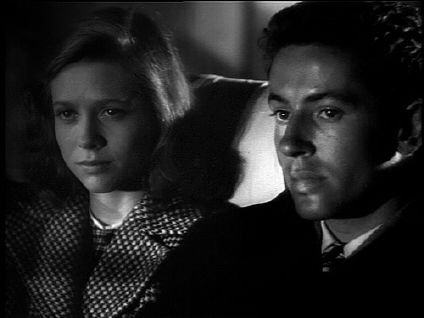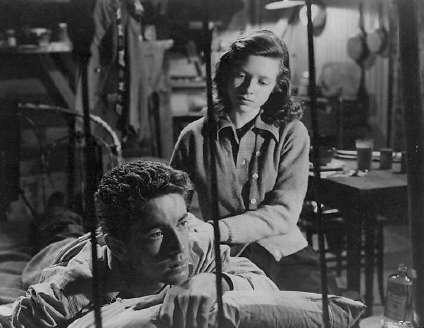
SECOND CHANCES
christopher funderburg
NICHOLAS RAY: Part III
page 2
They Live by Night

About ten minutes into this film, I exhaled in relief: here is a real movie. The meaning behind that thought was naturally a little imprecise, but let me try to explain it: there is something about They Live by Night that feels cinematically alive. The other films I've seen by Ray all had a certain constrained, artificial quality - hence my use of the words "phony," "cheesy," and "stilted" in my description of them. Even the biggest Ray admirer would have to admit that the four films I've previously watched by the director feel extremely stage-bound. They're coated with a thick veneer of "cinema" that never lets you forget that you are looking at lit screen in a dark room. They Live by Night, on the other, instantly feels more vibrant and accessible, as though there is nothing between the audience in the theater and the world of the film, no screen separating our reality from its reality. Part of this probably comes from the fact that the film opens with some soaring location photography, but They Live by Night feels like it's breathing in and out deeply, while Ray's other films feel stagy and static, plastic mock-ups of "characters" smothered under rigid blocking and generalized affect. In my write-up of Bigger than Life, I mentioned that it has some quality that would make it essentially silly to mention it in the same breath as Nights of Cabiria or A Face in the Crowd; while I don't think They Live by Night is as good as either of those films, to suggest that it might be would be completely reasonable. Here is a real movie.
The most noticeable difference has to do with the location photography peppered throughout the film - for all I know, just as much of this movie was shot on a soundstage as the other four, but here Ray redolently employs the interstitchal images of cars cruising over rural landscapes and dusty small-town settings. The feel of the evocative exteriors bleeds over onto the scenes shot on sets to give the film a more authentic feel overall. Heck, a shaggy dog wanders into frame early on and never shows up again - that's one of the small touches that feels tossed off and unplanned and real. It's interesting because my reaction to Ray so far has been that I don't think he's a tightly gripped or ultra-specific stylist: this decidedly isn't Ozu or Kubrick I'm writing about - but They Live by Night made me realize that there is something theatrical, or maybe just forced, that marks his work. The absence of those distancing, synthetic qualities in this film brings into sharp relief just how overbearing and relentless they are elsewhere in his work: if this is a real movie, the others are just movies.
 The plot follows a trio of escaped convicts, two hardened criminals ("Chicamaw" and "T-Dub") and one fresh-faced young man ("Bowie" - played by the dreamy Farley Granger). After quickly getting their bearings straight, the three men embark on a spree of bank robberies to turn a quick buck and get back on their feet. The plot takes a turn when Bowie gets badly injured in a car accident and Chicamaw has to kill a cop to get him away from the crash site. Bowie is left to recuperate with a young gas station attendant ("Keechie") and her drunken lout of a father (who is Chicamaw's brother). Sparks fly between Keechie and her convalescent charge, so the two hit the road, young lovers on the run trying to carve out space for themselves in a cruel world. It's easy enough to see touches of Rebel without a Cause and Knock on Any Door in that plotline, but the film feels so unlike any other movie I've seen by Ray, I'm reluctant to say it in any way resembles those other films. Really, in Ray's menagerie, Johnny Guitar and Rebel without a Cause are of a genus; this one is in another phylum altogether.
The plot follows a trio of escaped convicts, two hardened criminals ("Chicamaw" and "T-Dub") and one fresh-faced young man ("Bowie" - played by the dreamy Farley Granger). After quickly getting their bearings straight, the three men embark on a spree of bank robberies to turn a quick buck and get back on their feet. The plot takes a turn when Bowie gets badly injured in a car accident and Chicamaw has to kill a cop to get him away from the crash site. Bowie is left to recuperate with a young gas station attendant ("Keechie") and her drunken lout of a father (who is Chicamaw's brother). Sparks fly between Keechie and her convalescent charge, so the two hit the road, young lovers on the run trying to carve out space for themselves in a cruel world. It's easy enough to see touches of Rebel without a Cause and Knock on Any Door in that plotline, but the film feels so unlike any other movie I've seen by Ray, I'm reluctant to say it in any way resembles those other films. Really, in Ray's menagerie, Johnny Guitar and Rebel without a Cause are of a genus; this one is in another phylum altogether.
But there's been a catch for me with each Ray film I've seen so far and They Live by Night is no different: if I don't absolutely love this movie, it's only because it shares source material with another film I absolutely love. The perfectly understandable similarities to Robert Altman's Thieves Like Us, again and again reminded me of that superior film. After doing some advanced statistical analysis, my metrics tell me that Altman's film is 12.38 times better than Ray's and while They Live by Night is probably Ray's best work (Truffaut agrees with me on that), it still almost disappears in the shadow of Altman's take on Edward Anderson's novel. Farley Granger is fine as the handsome young Bowie, but he brings little to the role aside from his natural gentle sensitivity and movie star presence. Keith Carradine, on the other hand, is utterly dynamite - his mixture of goofy charm, world-weariness, gritty determination and yokel-ish earnestness is something truly special, a really original performance that makes Granger's take seem desperately bland and thin in comparison. In Ray's film, the car accident scene is great; in Altman's film, it is an unforgettable, film-changing turn. In Ray's film, the couple's intimate time in a secluded cabin is heartfelt and touching; in Altman's film it's poetic and utterly emotionally intoxicating. Altman's take is both more understated and more intense, a more authentic and textured rendering of reality but nevertheless peppered with edge-of-your-seat thriller set-pieces.
(continued on page 3 of "Second Chances: Nicholas Ray: Part III")
<<Previous Page 1 2 3 4 Next Page>>
home about contact us featured writings years in review film productions
All rights reserved The Pink Smoke © 2009